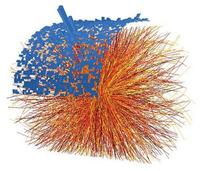Speaker
Karoly Uermoessy
(Hungarian Academy of Sciences (HU))
Description
Fragmentation functions measured in e+e- and pp collisions are well reproduced via a fragmentation model based on microcanonical statistics and superimposed Euler--Gamma-type multiplicity fluctuations [1,2]. The power of the obtained analytic fragmentation function (which is a cut-power function in x) develops a double-logarithmic dependence on the QCD scale Q^2 [3]. Besides, this function also describes transverse hadron spectra measured in pp and AA collisions at RHIC and LHC energies [4,5]. Interestingly, the power of the spectra of pions, kaons and protons stemming from pp collisions exhibits a similar double-logarithmic dependence on the collision energy sqrt{s} and on the hadron multiplicity N (measured in the |eta|<1 region) [6].
[1] K. Urmossy etal, Phys. Lett. B, 718 (2012) 125-129, arXiv:1204.1508
[2] K. Urmossy etal, Phys. Lett. B, 701 (2011) 111-116, arXiv:1101.3023
[3] G. G. Barnafoldi etal, Gribov 80 Conference: C10-05-26.1, p.357-363
[4] K. Urmossy etal, Phys. Lett. B, 689 (2010) 14-17, arXiv:0911.1411
[5] G. G. Barnafoldi etal, 'Hot Quarks 2010', J. Phys. Conf. Ser. 270 (2011) 012008
[6] K. Urmossy, Submitted to EPJC, arXiv:1212.0260
Author
Karoly Uermoessy
(Hungarian Academy of Sciences (HU))
Co-authors
Gergely Barnafoldi
(Hungarian Academy of Sciences (HU))
Tamas Sandor Biro
(MTA Wigner RCP)
Zhangbu Xu
(Brookhaven National Laboratory)
